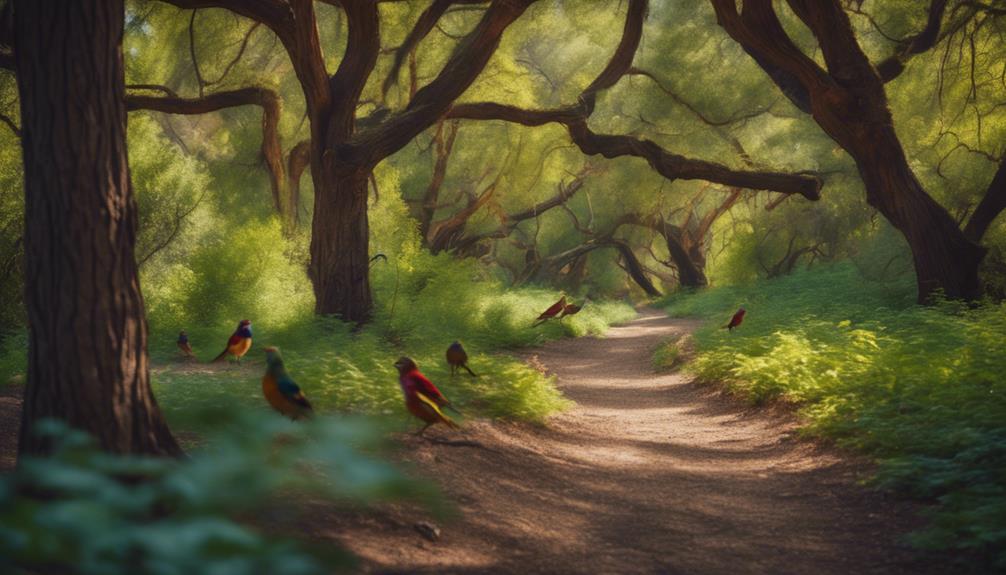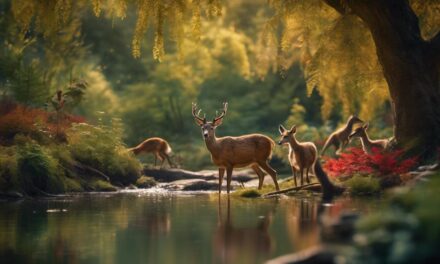Imagine stepping into Barstow Woods, where every trail leads to a unique birdwatching haven. You don't need to be an expert to appreciate the Main Entrance Trails, which offer easy access to a variety of bird species. Venture further to the Wetland Boardwalk, and you'll find yourself surrounded by waterfowl and shorebirds. The Forest Edge Pathways are perfect for spotting warblers and woodpeckers, while the serene Meadow Lookout Point provides panoramic views ideal for observing birds in flight. Curious about the elusive species found in the Pine Forest Nook? There's so much more to explore.
Key Takeaways
- The Wetland Boardwalk offers excellent views of waterfowl and shorebirds with a leisurely stroll on a managed boardwalk.
- The Main Entrance Trails provide easy access to birdwatching with well-marked paths and a rich avian life.
- The Forest Edge Pathways are ideal for spotting warblers and woodpeckers with well-maintained trails through wooded areas.
- Creekside Observation is best in the early morning, with common sightings of ducks and herons in optimal lighting conditions.
- Old Oak Grove is renowned for its towering oak trees and vibrant bird species, including warblers and woodpeckers.
Main Entrance Trails
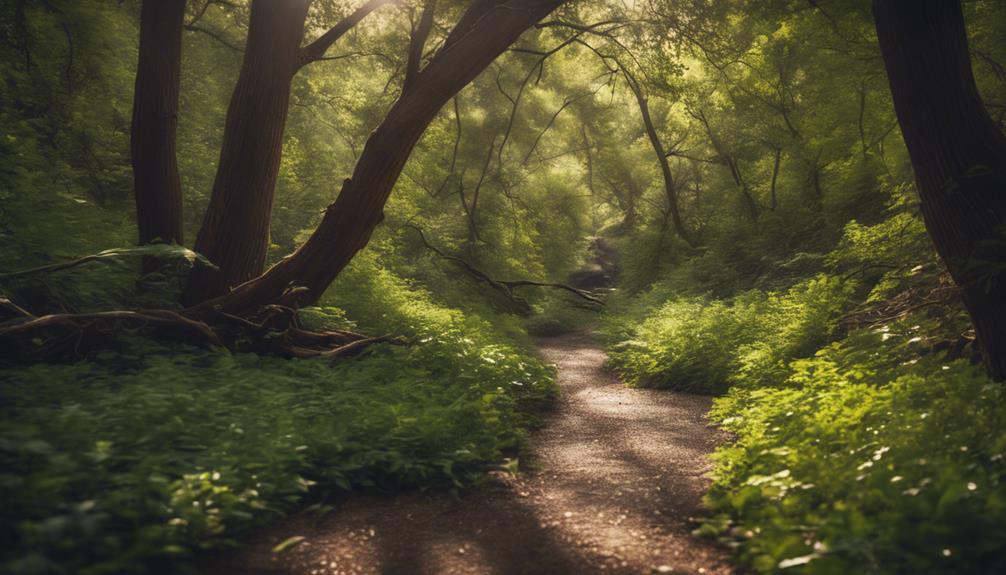
The main entrance trails at Barstow Woods offer a rich tapestry of avian life, making them an ideal starting point for any birdwatching expedition. As you traverse these paths, you'll notice the harmonious blend of flora and fauna that creates a thriving ecosystem. These trails provide easy access to birdwatching opportunities, allowing you to immerse yourself in the vibrant world of Barstow Woods.
As you begin your leisurely stroll, you're likely to encounter a variety of bird species. The dense canopy of trees and understory plants offer shelter and nesting sites for many birds. You might spot the striking Northern Cardinal flitting through the branches or hear the melodic song of the Eastern Wood-Pewee. The diverse vegetation supports a robust insect population, attracting insectivorous birds like the Black-capped Chickadee and the White-breasted Nuthatch.
The main entrance trails are popular among birdwatchers for good reason. They provide a welcoming environment for both experienced and novice birdwatchers. The well-marked paths allow you to explore at your own pace, ensuring you don't miss any avian activity. Observing birds in their natural habitat becomes an enriching experience as you witness their behaviors and interactions.
Barstow Woods' peaceful surroundings enhance your birdwatching experience. The rustling leaves and distant calls create a serene backdrop, making it easier to spot and identify various species. Whether you're an avid birder or a curious beginner, these trails offer a perfect introduction to the avian wonders of Barstow Woods.
The main entrance trails beckon you to discover the rich birdlife that thrives in this beautiful woodland setting.
Wetland Boardwalk
Nestled within Barstow Woods, the Wetland Boardwalk offers an unparalleled opportunity to observe waterfowl and shorebirds in their natural habitat. This managed boardwalk allows you to stroll leisurely while immersing yourself in the wetland ecosystem. Elevated above the ground, the boardwalk provides a prime vantage point for observing the diverse avian species that frequent the area without disturbing their natural behaviors.
As you walk along the wooden planks, you'll likely encounter herons, ducks, and a variety of other water-loving birds. The wetland's managed conditions create a thriving environment for these species, offering both food and shelter. Herons are often seen standing motionless, waiting to catch fish, while ducks might be spotted gliding smoothly across the water's surface, their reflections shimmering.
The Wetland Boardwalk is a favorite among birdwatchers seeking to capture stunning photographs or simply enjoy the sight of these majestic birds. The structure of the boardwalk ensures minimal human interference, allowing you to observe the birds' natural activities up close. Bring your binoculars and camera for a more enhanced experience; the elevated position of the boardwalk provides a clear line of sight over the marshy terrain.
This managed ecosystem not only supports a wide variety of bird species but also contributes to the overall health of Barstow Woods. The careful maintenance of the wetlands guarantees that the area remains a hospitable environment for wildlife, making the Wetland Boardwalk a must-visit spot for any birdwatching enthusiast.
Don't miss out on this unique opportunity to connect with nature and witness the rich biodiversity that thrives in this serene setting.
Forest Edge Pathways
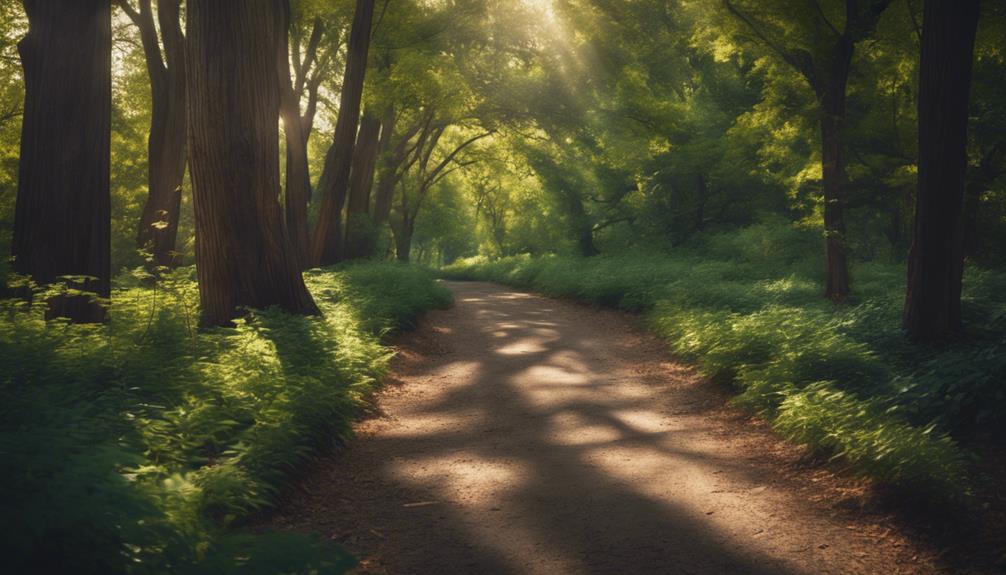
As you wander along the Forest Edge Pathways, you'll find prime observation locations where warblers and woodpeckers are frequently spotted.
The well-maintained trails guide you through a mix of wooded areas and open spaces, creating ideal habitats for various bird species.
Morning and evening visits increase your chances of encountering waterfowl and shorebirds near the wetlands and ponds.
Prime Observation Locations
Exploring the Forest Edge Pathways at Barstow Woods immerses you in a haven where warblers, woodpeckers, and sparrows thrive in their natural habitats. These trails run parallel to the Marquette Rail, providing a unique vantage point for observing a diverse range of bird species. As you walk along the forest edge, the dense foliage and tall trees create a perfect backdrop for spotting avian activity.
The pathways are meticulously designed to offer birdwatchers unobstructed views of the canopy and underbrush where birds often forage and nest. The wooded areas along these trails are teeming with insect life, making them prime feeding grounds for warblers. You'll often hear the rhythmic drumming of woodpeckers echoing through the trees, a telltale sign of their presence.
Sparrows, with their distinct calls and flitting movements, are frequently seen darting between the undergrowth and the lower branches. The forest edge pathways not only attract common species but also serve as a magnet for rarer birds, turning every visit into a potential treasure hunt.
Don't forget your binoculars; these trails offer some of the best close-up views of birds in their natural environment.
Species to Spot
You'll encounter a rich tapestry of avian life along the Forest Edge Pathways, with warblers, woodpeckers, and sparrows being among the most frequently observed species. The diverse habitat, merging wooded areas with open spaces, creates an ideal environment for these birds.
The warblers, with their vibrant plumage and melodic songs, are a delight to observe. You'll often find them flitting among the leaves, especially during migration seasons.
Woodpeckers, another common sight, can be spotted tapping away at tree trunks in search of insects. Their distinctive drumming sounds are a reliable indicator of their presence. Keep an eye out for the Downy and Hairy Woodpeckers, as they're the most frequently reported woodpecker species in this area.
Sparrows, although more understated in appearance, contribute significantly to the avian diversity along these pathways. Species like the Song Sparrow and the White-throated Sparrow are often observed foraging on the ground.
Additionally, the nearby wetlands and ponds attract waterfowl and shorebirds, enhancing the birdwatching experience. Early mornings and evenings are the best times to visit, as these periods offer excellent bird activity.
With the variety of birds reported, Forest Edge Pathways are a must-visit for any birdwatching enthusiast.
Meadow Lookout Point
Meadow Lookout Point offers you a panoramic view of Barstow Woods' meadows, making it an ideal spot for observing a variety of bird species such as warblers, sparrows, and woodpeckers. Positioned at an elevated vantage point, this location allows you to scan both woodland and open-field habitats, providing a rich diversity of avian life.
To maximize your bird-watching experience at Meadow Lookout Point, consider the following tips:
- Check eBird for Recent Sightings: Before you head out, visit the [WebsiteAbout eBird](https://www.ebird.org) to check recent sightings in the area. eBird is a valuable resource for understanding which species have been recently observed.
- Bring Binoculars and a Field Guide: Essential tools for any birdwatcher, binoculars will help you get a closer look at distant birds, while a field guide can assist in identifying different species.
- Visit During Peak Activity Times: Early mornings and late afternoons are typically the best times for bird activity. Plan your visit accordingly to observe the highest number of species.
The meadows themselves are a thriving ecosystem. Warblers flit about the shrubbery, while sparrows forage on the ground. Woodpeckers can often be heard before they're seen, their distinct drumming resonating through the woods.
The peaceful ambiance at Meadow Lookout Point offers a serene backdrop, enhancing your overall experience.
Observing birds here isn't just a visual delight but also an auditory one. The chorus of bird songs and calls provides a natural symphony that complements the visual spectacle. Whether you're a seasoned birder or a curious novice, Meadow Lookout Point in Barstow Woods is a must-visit spot for anyone keen to immerse themselves in avian wonders.
Creekside Observation
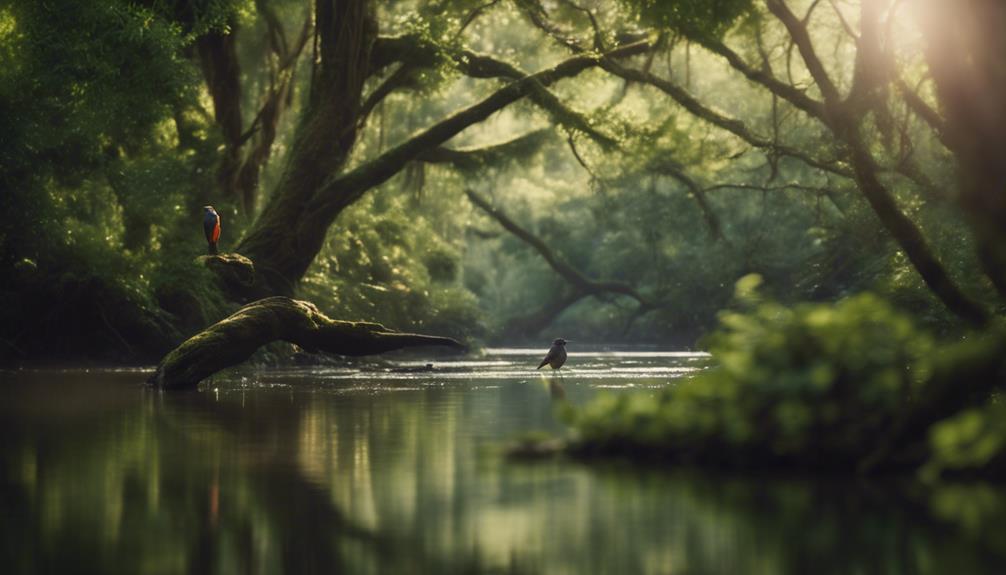
At Creekside Observation, you'll find the best birdwatching early in the morning when waterfowl activity peaks.
Species commonly seen include ducks, herons, and other water-dependent birds.
Bring binoculars and a field guide to enhance your experience and help identify the diverse avian visitors.
Optimal Viewing Times
Early mornings and late afternoons are prime times for birdwatching at Barstow Woods' Creekside Observation area, with peak bird activity and ideal lighting conditions enhancing visibility. During these periods, birds are most active, presenting a perfect opportunity to spot a variety of species. Migratory birds, in particular, tend to be more visible, adding to the diversity you can observe.
The soft, natural light at these times also guarantees clearer views, making it easier to distinguish between species.
When planning your visit, consider the following tips to maximize your experience:
- Arrive Early or Stay Late: Be there during the first couple of hours after sunrise or the last few hours before sunset to catch birds at their most active.
- Use Ideal Equipment: Bring binoculars or a spotting scope to get up-close views of birds without disturbing them.
- Document Your Findings: Take notes or photographs of what you see. Many birdwatchers share their observations in public domain CC0 platforms, contributing valuable data for bird conservation efforts.
Common Bird Species
You'll find Barstow Woods' Creekside Observation area teeming with diverse bird species like warblers, woodpeckers, and sparrows, each contributing to the rich avian tapestry. The warblers, with their vibrant plumage and melodic songs, are a delight to observe. These small passerines are an essential part of the birdwatching experience in the United States, particularly during migration seasons. You'll spot species such as the Yellow Warbler and the Black-and-White Warbler flitting through the foliage.
Woodpeckers are another highlight in this area. The rhythmic drumming of the Downy Woodpecker and the striking red crest of the Pileated Woodpecker are hard to miss. These birds play an important role in the ecosystem by controlling insect populations and creating nesting cavities used by other species.
Sparrows, often overlooked, offer subtle beauty and intriguing behavior. The Song Sparrow, with its distinctive, melodious tune, and the White-throated Sparrow, identifiable by its white throat patch and yellow lores, are common sights along the creekside.
Barstow Woods' mix of wooded areas, wetlands, and ponds creates an ideal habitat for these bird species, making it a prime birdwatching destination in the United States.
Essential Gear Tips
Equipping yourself with the right gear can greatly enhance your birdwatching experience at Barstow Woods' Creekside Observation area. Start by bringing a good pair of binoculars. They'll help you get a closer look at the diverse bird species without disturbing their natural behavior.
Wearing neutral-colored clothing is important to blend in with your surroundings, making your presence less intrusive to the birds.
To maximize your bird identification success, carry a field guide. This tool will be invaluable for recognizing various species you might encounter.
Staying hydrated and energized is vital, so pack a water bottle and some snacks.
To ensure a comfortable outing, bring insect repellent to protect yourself from bugs that thrive near the creek.
Here are three key items to enhance your Creekside birdwatching experience:
- Binoculars: Essential for close-up views of birds without causing disturbance.
- Field Guide: Handy for identifying different species in the area.
- Insect Repellent: Necessary to keep bugs at bay while you enjoy the outdoors.
For more tips and gear recommendations, check the public resources available on the [Barstow Woods WebsiteAbout](https://www.barstowwoods.org). This will help you prepare for an enjoyable and successful birdwatching trip.
Old Oak Grove
Exploring Old Oak Grove in Barstow Woods Park offers birdwatchers a prime opportunity to observe diverse avian species in their natural habitat. This section of the park is renowned for its towering oak trees and serene atmosphere, making it a magnet for both resident and migratory birds.
As you wander through Old Oak Grove, your eyes might catch a glimpse of vibrant warblers flitting among the branches. These small, colorful birds are often seen during their migration periods, adding a splash of color to the dense foliage. The grove's tranquility also makes it an ideal spot for woodpeckers. Listen for the distinct drumming sounds they produce as they search for insects in the tree bark. Species like the Downy Woodpecker and the Northern Flicker are common residents here.
The diverse flora of Old Oak Grove supports a rich ecosystem, providing ample food sources and nesting sites for various bird species. You'll find that the birds' behavior is particularly fascinating to observe in such a natural setting. Watch as they engage in courtship displays, territorial disputes, and intricate nest-building activities. The grove's canopy offers a protective cover, encouraging a wide array of avian interactions just above your head.
Whether you're a seasoned birder or a curious newcomer, Old Oak Grove promises a rewarding birdwatching experience. The combination of its peaceful surroundings and robust bird population assures that each visit offers new and exciting observations.
Keep your binoculars handy, stay attentive, and immerse yourself in the vibrant bird life that thrives in this exceptional part of Barstow Woods Park.
Pine Forest Nook
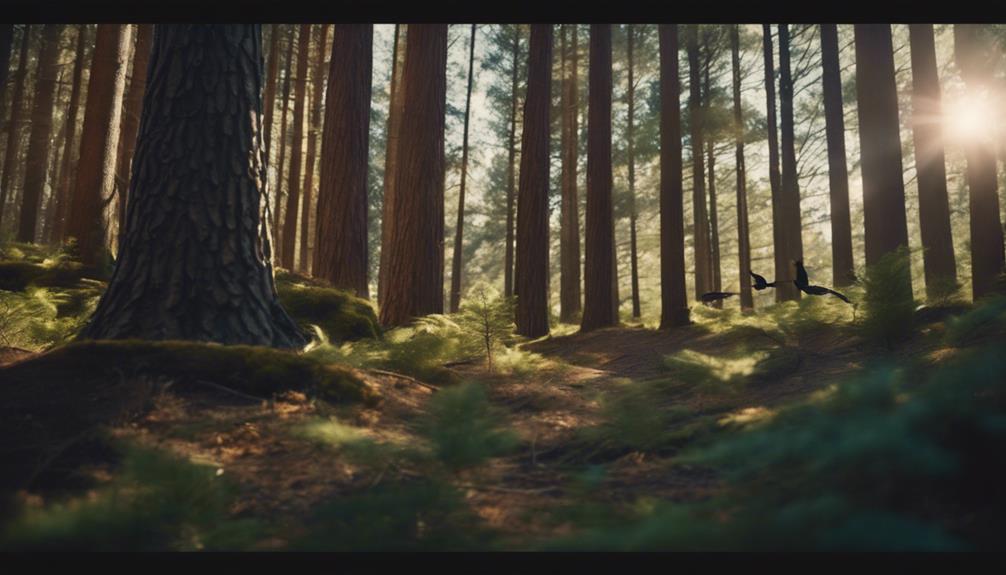
At Pine Forest Nook, you'll find a haven for birdwatching with species like woodpeckers, nuthatches, and warblers commonly seen among the tall pines.
Early mornings and late afternoons provide the best opportunities for spotting these birds as they're most active during these times.
The dense canopy and serene setting offer a rich and immersive experience for both novice and experienced birders.
Common Bird Species
Nestled within Barstow Woods Park, Pine Forest Nook teems with an array of bird species, including warblers, woodpeckers, and sparrows, making it a prime spot for keen birdwatchers. This section of the park, much like City Forest, offers a rich habitat that attracts both resident and migratory birds.
Here, you can frequently spot chickadees, nuthatches, and finches flitting among the trees. The diverse foliage provides ample opportunities for bird identification and observation.
As you stroll through Pine Forest Nook, keep an eye out for the vibrant warblers darting through the canopy. You'll also notice the rhythmic tapping of woodpeckers, a sound that adds to the forest's natural symphony. Sparrows, with their distinctive calls, are often found foraging on the forest floor.
To make the most out of your birdwatching experience in Pine Forest Nook, consider the following:
- Carry a Field Guide: This helps you identify the various bird species you encounter.
- Bring Binoculars: Essential for getting a closer look at birds high up in the trees.
- Visit During Early Morning: Birds are most active during this time, enhancing your chances of spotting diverse species.
Best Viewing Times
To maximize your birdwatching experience in Pine Forest Nook, head out during the early mornings or evenings when bird activity is at its peak. These times align with the birds' natural feeding and social behaviors, making them more visible and vocal.
Pine Forest Nook, nestled within Barstow Woods, is especially vibrant during spring and fall, when migratory patterns bring a diverse array of species.
In the early mornings, you'll often hear the melodic songs of warblers and catch sight of woodpeckers foraging on tree trunks. Evenings are equally rewarding, with sparrows and other small birds becoming more active as the day cools. The wooded areas and open spaces of Pine Forest Nook provide ideal habitats, allowing you to observe these species in their natural behaviors.
Additionally, wetlands and ponds within Barstow Woods attract waterfowl and shorebirds. Early morning mist over the water creates a serene backdrop, perfect for spotting ducks and herons. Evenings often bring groups of shorebirds to the water's edge, pecking for food before nightfall.
Woodland Pond Area
The Woodland Pond Area in Barstow Woods teems with an impressive array of bird species, making it a prime location for avid birdwatchers. This area is a true hotspot, drawing in a diverse range of birds due to its rich habitat diversity. Whether it's the open water of the pond, the muddy shorelines, or the dense canopy of surrounding trees, each niche supports a variety of avian life.
At the pond, you'll encounter waterfowl like ducks and geese, gliding gracefully across the water. Shorebirds such as sandpipers can often be seen foraging along the edges, their quick movements and distinctive calls adding to the vibrant scene. The trees encircling the pond are alive with the sounds of songbirds and woodpeckers, creating a chorus that's both soothing and exhilarating.
To make the most of your visit to the Woodland Pond Area, consider these tips:
- Bring Binoculars and a Field Guide: Enhancing your ability to spot and identify different species, binoculars and a guidebook are essential tools for any birder.
- Visit During Early Morning or Late Afternoon: These times are when birds are most active, increasing your chances of sighting various species.
- Stay Quiet and Patient: Birds are sensitive to noise and movement. By maintaining a low profile, you'll have a better opportunity to observe their natural behaviors.
The tranquil setting of the Woodland Pond Area not only offers a perfect escape into nature but also provides a peaceful environment for observing and appreciating the rich birdlife in Barstow Woods.
Whether you're an experienced birder or a curious newcomer, this hotspot is sure to captivate and inspire.
Bird Feeder Stations
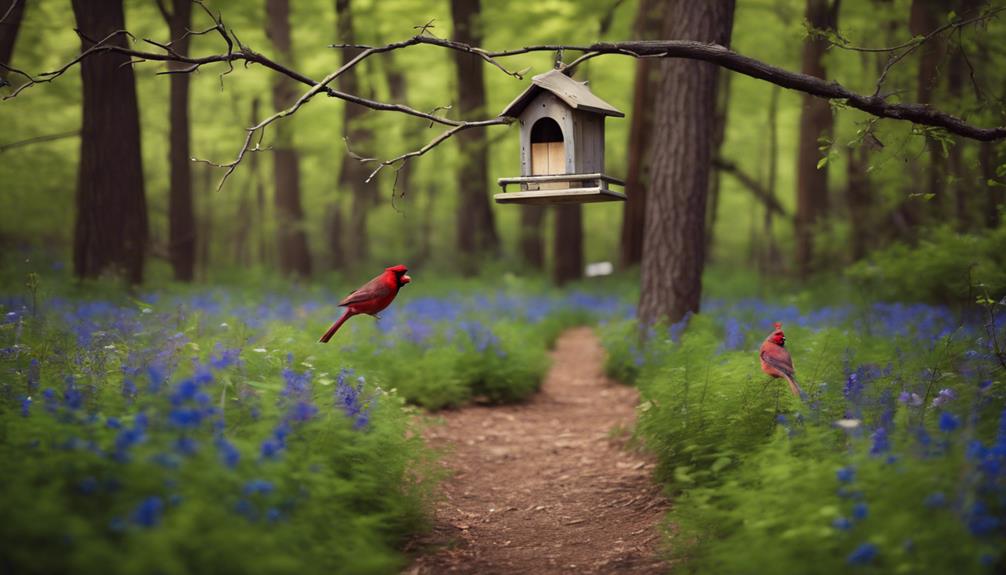
After exploring the vibrant Woodland Pond Area, you'll find another fantastic birdwatching spot at Barstow Woods with its well-maintained bird feeder stations. Strategically placed throughout the park, these stations attract a diverse array of bird species, providing you with incredible opportunities for close-up observation and photography.
At the feeder stations, you'll see chickadees, nuthatches, woodpeckers, and finches regularly visiting for food. The stations are stocked with fresh seeds and suet, guaranteeing the local avian population is well-nourished. This intentional maintenance not only supports the birds' health but also enriches your birdwatching experience by increasing the likelihood of sightings.
You can get detailed information about the bird species you observe through resources like eBird, a thorough online database for birdwatching enthusiasts. By visiting the Barstow Woods page on their website, you can find out more about the kinds of birds that frequent the feeder stations. If you're new to birdwatching or need specific advice, don't hesitate to contact local birdwatching groups or park authorities for guidance.
For those interested in sharing their findings or contributing data, eBird offers a simple process to log your observations. This data can be valuable for scientific research and helps enhance our understanding of bird populations.
Remember to respect the park's guidelines and licenses regarding feeding and interacting with wildlife. By doing so, you'll ensure that Barstow Woods remains a thriving habitat for these beautiful creatures.
Seasonal Migratory Spots
During spring and fall migrations, Barstow Woods transforms into a bustling hub for birdwatchers excited to observe the diverse array of species passing through. The seasonal changes bring a variety of birds like warblers, woodpeckers, and sparrows, making it a prime location for anyone passionate about ornithology.
To maximize your birdwatching experience, visiting the park during early mornings and late evenings is essential, as these times are when birds are most active.
Barstow Woods' varied terrain, including dense wooded areas, open fields, and wetlands, creates ideal habitats for different bird species. The wetlands and ponds particularly attract waterfowl and shorebirds, adding another layer of diversity to your sightings. Birdwatchers often find these features to be among the top hotspots in the park.
Here are three specific hotspots where to go in Barstow Woods during migrations:
- Wetland Areas: The ponds and marshes are where you'll find waterfowl like ducks and geese, as well as shorebirds such as sandpipers and plovers. These areas are particularly active during migration seasons.
- Wooded Trails: Navigate through the dense forest paths to spot warblers, woodpeckers, and other songbirds. The trees provide shelter and food, making these trails a birdwatcher's paradise.
- Open Fields: In the open spaces, you can observe ground-feeding birds like sparrows and finches. These areas are also excellent for raptor sightings, as hawks and eagles often hunt in open terrain.
Frequently Asked Questions
Where Is the Best Place to See Birds?
To see the best bird migration, you'll want to visit areas with rich habitats. Head to wooded areas and wetlands. These spots offer food and shelter, attracting diverse species.
Mornings and evenings in spring and fall are prime times. Look for warblers in the trees and woodpeckers near the trunks. Wetlands and ponds will have sparrows and other water-loving birds. Bring your binoculars for a closer look.
Where Can You See Birds in California?
In California, you can observe a vast array of bird species in local parks. Point Reyes National Seashore offers coastal habitats, while Yosemite National Park boasts mountainous regions. Don't miss the Salton Sea's unique desert environment.
California's diverse landscapes, including wetlands and forests, attract over 600 bird species. Thanks to its position on the Pacific Flyway, you'll enjoy spotting migratory birds like the California Condor and Allen's Hummingbird.
Where Is the Best Bird Watching in the World?
When you're seeking global hotspots for bird watching, consider Barstow Woods Park in Midland, Michigan. This renowned location offers a diverse range of bird species in various habitats like wooded areas and wetlands.
You'll observe warblers, woodpeckers, and sparrows, especially during mornings and evenings.
This park's scientific appeal lies in its rich biodiversity, making it one of the best bird watching destinations in the world.

